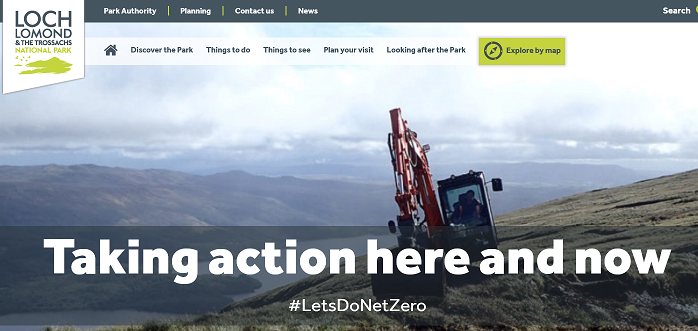
The Loch Lomond and Trossachs National Park Authority (LLTNPA) website has had a makeover. If you click on their site address https://www.lochlomond-trossachs.org/ you are greeted by a photo of a digger in the uplands, the hashtag slogan “Let’s do net zero” and a page of links to information on various aspects of the “climate emergency and nature crisis”. Some of the content was also included in the LLTNPA’s latest “Update to Stakeholders” which is all about the climate emergency and was issued on 12th November, the last day of COP-26 in Glasgow. This post takes a critical look at the LLTNPA’s claims to be “Taking action here and now” and the interests at stake.
The Climate Emergency – according to the LLTNPA
The Climate Emergency page (see here) starts as follows:

Really? Does the LLTNPA know of anywhere on earth that hasn’t evolved “over many thousands of years”? Does the LLTNPA know of any landscape on earth that isn’t “alive”?
Well there may be some but even the site of the Chernobyl nuclear reactor is now a wildlife reserve. However, come to think of it, if I was forced to choose between which term best described the landscape of the National Park, “alive” or “dead”, I would choose the latter. The landscape has been trashed through industrial forestry, overgrazing by sheep and deer and inappropriate developments, from badly designed hydro schemes to Transport Scotland’s current proposals to upgrade the A82, while meantime the rural depopulation continues with local people priced out of the market by second homes………..
Then there is the staggering claim that “the impacts of climate change are already being felt across the National Park”. The first COP summit, held because of scientific concerns about the impact of climate change, took place in 1995 in Berlin. But to admit that the effects of climate change were being documented before the LLTNPA existed would be to admit that it has failed to take any meaningful action since it was created in 2002.
The LLTNPA is a stronger ground when it states the impacts of global warming are increasing and, having blogged extensively about landslips in the National Park, it is good to see the LLTNPA acknowledge their impact:
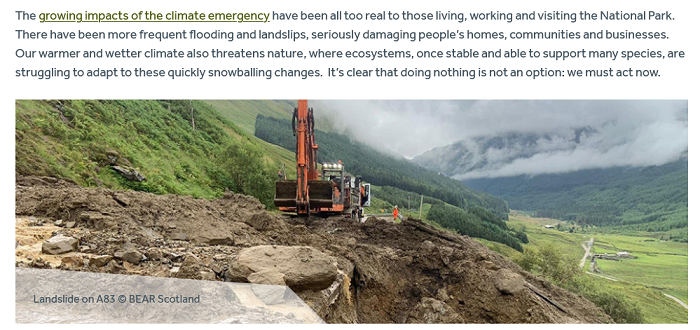
But despite the numerous landslips in the National Park (see here for example) the LTTNPA Board has still failed to discuss what needs to be done about them, and in the case of the Rest and Be Thankful (photo above) has in 15 years never criticised the stupidity of allowing grazing to continue on the disintegrating slopes above the A82 (see here).
The LLTNPA’s statement that ecosystems were “once stable and able to support many species” is just wrong. Our ecosystems have been in a constant state of flux since the last ice age, partly due to variations in climate but also because of the way landowners have used the land since people were cleared from it: hunting reserves, sheep ranching, industrial forestry etc. It is those land-uses, rather than climate change, which account for the lack of biodiversity in the National Park.
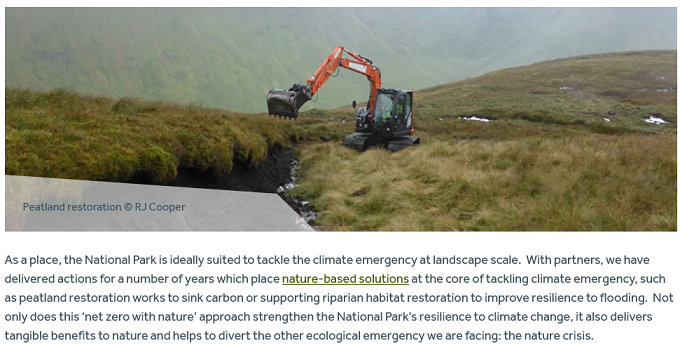
“As a place……….” is meaningless parkspeak. What reasonably large area, Glasgow, Argyll and Bute, Scotland, wouldn’t be “ideally suited” to tackle the climate emergency at the landscape scale?
Still, setting aside the spin, the poor science and the ignorance of history, one could argue it is a step forward that the LLTNPA are now acknowledging so publicly the climate emergency and nature crisis.
What about the action?

The first two lines are good but the LLTNPA then commit to almost nothing. Their grand plan, branded “our mission zero” (see here), is to go carbon neutral in their own operations by 2030 (while excluding any consideration of the emissions which result from staff getting to work or working from home). After screeds of guff, the actions required to achieve this limited carbon neutrality are set out their Mission Zero route map:
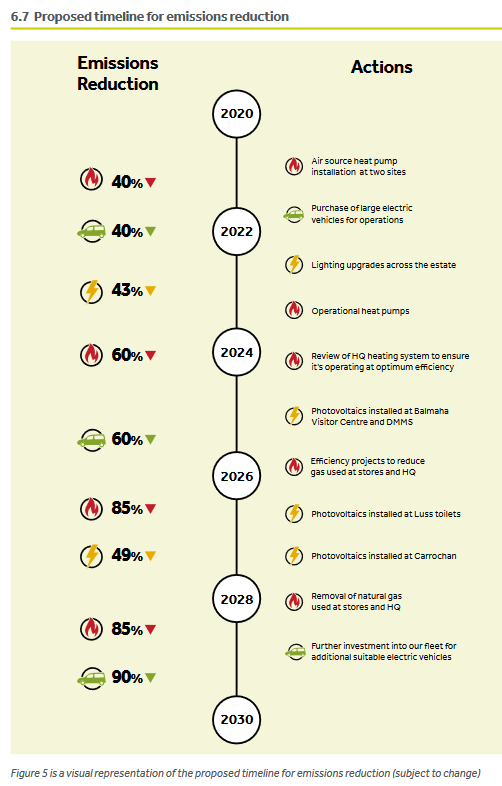
This can be summarised as change the light bulbs, install heat pumps and photovoltaic panels and use electric cars. All this could be done in the next two years, given the will and if those responsible acted as if there was an emergency. After lots of blah, blah, blah the actions are thinly spread.
The timing of these investments will, however, have been determined by likely future allocations of capital expenditure from the Scottish Government. It appears that the LLTNPA has agreed with officials to spend these on going carbon neutral. Whether the money might be spent elsewhere for greater impact does not appear to have been considered. But as long as current spending limits and the pitiful levels of public investment apply, I would expect the LLTNPA to have less money to invest in carbon friendly activities like outdoor recreation over the next 8 years.
In fact, the best way now of understanding what the LLTNPA does and doesn’t do (or says and doesn’t say) is to follow the Scottish Government funding. For example, the LLTNPA is promoting peatland restoration (hence all the photos of diggers), because that is funded through the Scottish Government, but meantime failing to exercise “its moral and statutory obligation” to speak out about issues like industrial forestry and overgrazing which are bad for nature and bad for carbon.
By contrast (see here) at least the Cairngorms National Park in their new draft Partnership Plan is prepared to consider carbon emissions across the National Park as a whole and, however weak their targets, and does have half a plan. The new Minister for National Parks, Lorna Slater, really does need to get a grip of the LLTNPA.
Inspired leadership or…………….?
At the bottom of the newsletter to stakeholders (see here) there is an article about how the Convener of the LLTNPA, James Stuart, brokered a joint statement on the role of protected areas in combating climate change that was launched at the COP summit day on youth and public empowerment:
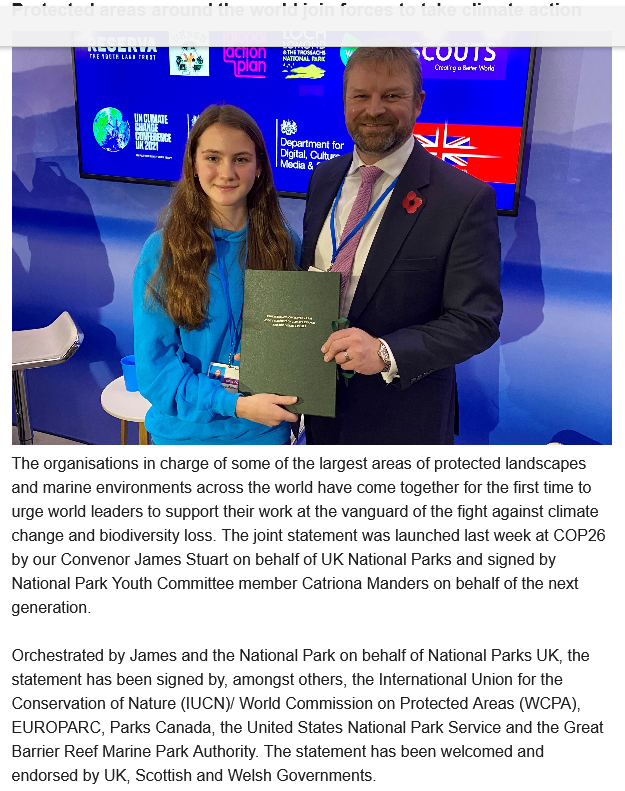
It may be the first time organisations managing protected areas have called on world leaders to support their work and combat BOTH climate change and biodiversity loss, but the International Union for the Conservation of Nature has been doing work on climate change and National Parks for quite some time (see here). For example “Natural Solutions: protected areas helping people to cope with climate change” was published back in 2010. But when it comes to spin and self-promotion, people will claim anything.
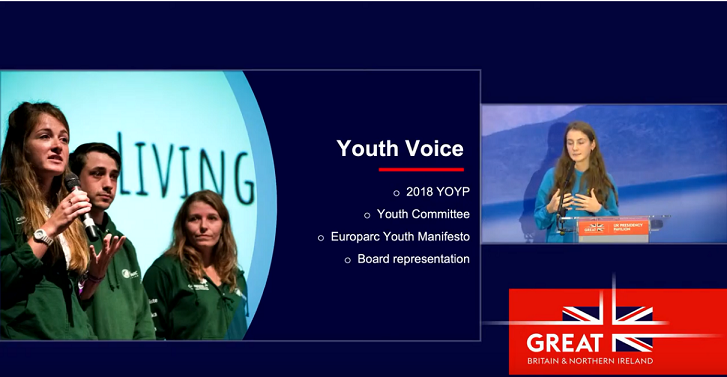
Catriona Manders, the young person photographed alongside James Stuart, spoke at the youth day at COP (see here – at 40 mins) and said very little about the bullet point ” Board Representation”. I was not surprised as I cannot recall a young person attending the Board since early 2019, despite James Stuart staking his reputation then on meaningful youth involvement.
Unfortunately, there is no transparency about who is on the youth committee, how often it meets and what it discusses (see here). I had assumed, maybe wrongly, that after the young people who were involved two and a half years ago had identified the lack of public transport as their number one priority, the LLTNPA had taken fright and shelved the committee. The LLTNPA website claims, however, it meets four times a year.
Catriona Manders also wrote a blog for the National Park (see here) in which she warned against tokenism:

Perhaps the LLTNPA could now come clean about whether they have been putting as much effort into responding to what young people have been saying as arranging high profile photo opportunities for their convener?
James Stuart is also a director of National Parks UK Ltd which is currently being liquidated (see here) and chair of National Parks UK. He used that organisation to orchestrate the agreement. It issued a considerably longer news release (see here) than the IUCN and contains some additional information which should be of public interest:
“In October this year, National Parks UK announced its unique Revere nature restoration facility in collaboration with global impact firm Palladium. Through Revere, businesses and investors can fund Nature-based Solutions (NbS) in UK National Parks and support land managers to develop nature restoration models that can generate revenue through sale of ecosystem services. Revere aims to leverage £240million of private finance for nature recovery projects by 2030.”
Stuart commented: “Revere is a good example of the sort of new thinking that can be created in one country and shared with other protected landscapes worldwide. In the UK we see the role of National Parks as innovation engines for green recovery. We can trial new approaches at a scale that makes an immediate impact and because we already have the management structures in place, we can do this rapidly to prove concepts that can then be used in other landscapes either in the UK or around the world.”
James Stuart appears to want to increase the involvement of private finance in our National Parks, through “nature based solutions”, and then offer those solutions to the rest of world. Indeed, he has been working on this for some time through his business, One Planet Consulting (see here), based down in Darlington. Whatever the other reasons for being there, James Stuart’s attendance at COP will have also presented a business opportunity. How he managed the potential conflicts of interest is unclear. But it seems to me that given his business interests and given that he has apparently moved to Darlington, the right thing for him to do would be to resign from the LLTNPA Board and National Park UK.
As for the protected areas statement itself (see here), the founding signatories are predominantly from the richer English speaking world and exclude most of the poorer countries that will be most affected by climate change. Despite the delegations from indigenous peoples to the COP summit and despite the IUCN’s recognition in 2019 that 37% of the carbon in protected areas across the world are on indigenous people’s lands (see here), none appear to have signed up. While the statement includes a reference to indigenous peoples, perhaps those at the summit weren’t asked? Or maybe they objected to the content (see here for an indigenous critique of National Parks)?
Whatever the explanation, I suspect that the top down “western leadership” and lack of engagement, exacerbated no doubt by the wish for a photo opportunity at COP, may sadly rebound on the IUCN.

I get confused. Is it Loch Lomond they mean or Stratford on Avon? lol We are over 40 years in on this. I think Cory Morningstar fb has a good take on it. @elleprovocateur Twitter and YTube.. She takes the impacts on the Global South into account. As usual the warmongering imperialist contribution was left out….”for reasons of National Security.” The Greta Project is a front and a scam….window dressing for Wall St, finance capital and $multi-trillion investments in emerging markets. All of the greenwash NGOs, trusts, charities and foundations are all “on message.” All virtue signalling and massaging their ruling class egos. Colin Adams at the Field Station should have a good take and my cuz, Prof of Geology at Glasgow Uni. The fisheries have studied the climate for a long time….especially the marine climate. I stopped following it after the Stern Review, 2006. We’re screwed. The merchant bankers are all over it. They’re monetising the lot. There will be a price tag on every blade of grass and on every leaf on every tree. And The NP/ScotGov will be there to cheer them on. Potholer54 on YTube is good too. Still, I reckon it’s all over….unless you can afford to get off the earth and find another habitable planet. People don’t realise how thin the atmosphere is. If you stood up Loch Lomond twice that height is most of the atmosphere. I told Don Staniford to contact you viz farmed salmon.